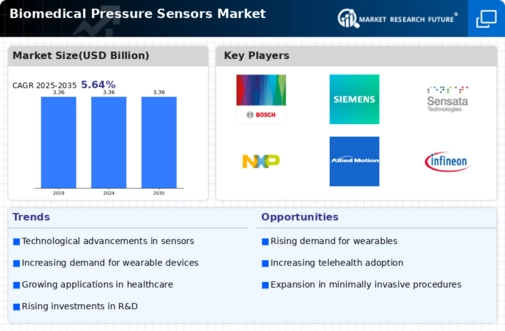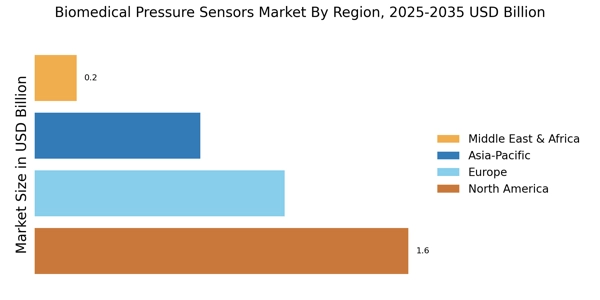Growing Focus on Preventive Healthcare
The Biomedical Pressure Sensors Market is benefiting from a growing focus on preventive healthcare. As healthcare systems shift from reactive to proactive approaches, the demand for devices that facilitate early detection and continuous monitoring of health conditions is increasing. Biomedical pressure sensors play a pivotal role in this transition, allowing for timely interventions and better management of health issues. The market is expected to witness a notable increase in adoption rates, as healthcare providers recognize the importance of preventive measures. This trend is likely to drive innovation and investment in the development of advanced pressure sensing technologies.
Increasing Prevalence of Chronic Diseases
The rising prevalence of chronic diseases is a critical driver for the Biomedical Pressure Sensors Market. Conditions such as hypertension and diabetes necessitate continuous monitoring of physiological parameters, including blood pressure. This growing need for monitoring devices is propelling the demand for biomedical pressure sensors. According to recent estimates, the number of individuals diagnosed with hypertension is expected to reach over 1.5 billion by 2025, further emphasizing the need for effective monitoring solutions. Consequently, the industry is likely to expand as healthcare systems seek to implement more comprehensive monitoring strategies to manage chronic conditions effectively.
Rising Demand for Home Healthcare Solutions
The demand for home healthcare solutions is significantly influencing the Biomedical Pressure Sensors Market. With an increasing number of patients preferring to receive care at home, there is a growing need for portable and user-friendly monitoring devices. Biomedical pressure sensors are essential in this context, enabling patients to monitor their health conditions independently. The market for home healthcare devices is projected to grow substantially, with estimates suggesting a compound annual growth rate of around 10% in the coming years. This trend indicates a shift in healthcare delivery models, further driving the demand for biomedical pressure sensors.
Technological Advancements in Sensor Design
The Biomedical Pressure Sensors Market is experiencing a surge in technological advancements that enhance sensor design and functionality. Innovations such as miniaturization and integration of smart technologies are driving the development of more efficient and accurate pressure sensors. These advancements enable real-time monitoring and data collection, which are crucial for patient care. The market is projected to grow at a compound annual growth rate of approximately 8.5% over the next few years, indicating a robust demand for advanced biomedical pressure sensors. As healthcare providers increasingly adopt these technologies, the industry is likely to witness a significant transformation, improving patient outcomes and operational efficiency.
Regulatory Support and Standardization Initiatives
Regulatory support and standardization initiatives are crucial drivers for the Biomedical Pressure Sensors Market. Governments and regulatory bodies are increasingly recognizing the importance of ensuring the safety and efficacy of medical devices. This has led to the establishment of stringent guidelines and standards for biomedical pressure sensors, fostering innovation and encouraging manufacturers to invest in research and development. As compliance with these regulations becomes essential, the industry is likely to see a rise in the quality and reliability of pressure sensing technologies. This regulatory landscape not only enhances consumer confidence but also stimulates market growth.


















Leave a Comment